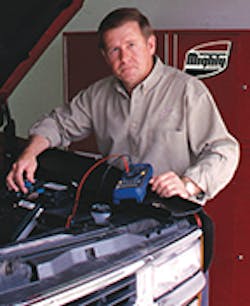Maintenance Really Matters: The Technician is the Maintenance Reminder Light
You are the maintenance reminder light and it’s not a job to be taken lightly. Your customers trust you with their second most expensive investment. The instrument cluster is filled with gauges and lights that reflect the operating conditions of the engine. Unfortunately, many vehicle owners have become accustomed to relying on these instruments or warning lights as the sole informer of any necessary services.
While there is an indicator for many problems that need attention such as a service engine light, alternator/battery, low coolant, low brake fluid, change oil, etc. there more maintenance is required. Relying solely on a warning light results in a lot of preventative maintenance services being neglected and some expensive repairs. You have a responsibility to perform a thorough inspection and to make recommendations to the vehicle owner on what services should be performed as a part of the recommended vehicle maintenance. Most vehicle owners are not aware of the required maintenance that is necessary to keep their vehicle in good operating order. It is our job to assume this responsibility. You are the maintenance reminder light.
Often we get into a pattern of only inspecting and recommending the services we specialize in. The customer assumes we are performing all required services and performing a full inspection on the vehicle. The end result is a lot of needed services are not being performed, resulting in some costly repairs. In a worst case scenario the customer gets stranded on the highway because we failed to perform a thorough inspection on their vehicle. Let’s consider a few cases of neglect when performing inspections:
1. Failure to test the condition of the battery is a good example. Battery testers are available that will determine the condition of the battery long before the customer encounters a no-start condition, often requiring a wrecker/service call. The wrecker call can exceed the cost of a new battery. And what happens when they determine that this was preventable?
2. Suspension components wear resulting in damaged tires due to misalignment, requiring premature replacement.
3. Brake friction gets replaced, but we fail to recommend a brake system fluid flush. During a panic-braking situation the moisture laden fluid may turn to vapor due to the intense heat, resulting in a loss of brake pedal. Inspect the brake lines for corrosion, which can result in brake failure during a panic stop. Pay special attention to the brackets that secure the brake lines, as this is an area that often traps road debris and salt. The brake lines are the veins/arteries that distribute the fluid to the hydraulic components, which provide the clamping forces necessary to stop the vehicle. Contamination, corrosion or leakage can lead to a catastrophic event.
4. Do you limit your filter replacement recommendations to the oil and air filters? What about the cabin air filter? Chances are your customer is not aware that their vehicle is equipped with one. Are you recommending a fuel filter replacement? A restricted fuel filter can affect engine performance and lead to premature electric fuel pump failure, costing hundreds of dollars in repair cost.
5. Identifying a leaking water pump can generate more than a water pump replacement. For example, it could indicate a cooling system flush, new antifreeze, thermostat, hoses, belts and possibly a new belt tensioner.
6. Most vehicle owners do not understand the difference between severe and normal service operating conditions. Most are surprised to learn that they operate their vehicle under a severe service category, which requires more frequent oil and filter changes.
Perform a thorough inspection and provide the customer with your service recommendations, even if it requires another shop to perform some of those services. They will appreciate the attention given. Remember, you are the maintenance reminder light for your customer’s vehicle. They will appreciate a thorough and professional vehicle inspection. Take the time to fully explain the results of the inspection and any service recommendations.
LARRY HAMMER is an automotive troubleshooter who oversees Mighty’s Technical Support Services in Jackson, Tennessee. Hammer has been writing technical articles since 1982. He may be reached at: [email protected]
About the Author

